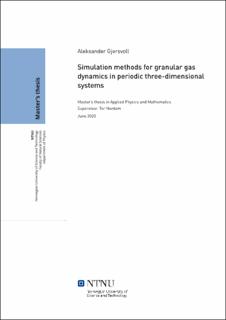| dc.contributor.advisor | Nordam, Tor | |
| dc.contributor.author | Gjersvoll, Aleksander | |
| dc.date.accessioned | 2021-09-28T18:36:37Z | |
| dc.date.available | 2021-09-28T18:36:37Z | |
| dc.date.issued | 2020 | |
| dc.identifier | no.ntnu:inspera:57076746:37770507 | |
| dc.identifier.uri | https://hdl.handle.net/11250/2785535 | |
| dc.description.abstract | I denne masteroppgåva studerar me granulær gassdynamikk, der me har antatt at dynamikken til ein granulær gass er bestemt av momentane parvise uelastiske partikkelkollisjonar, og kollisjonane er gitt av ein konstant restitusjonskoeffisient. Ein granulær gass skiljer seg derfor frå ein molekylær gass, der partikkelkollisjonane er elastiske. For å studere granulær gassdynamikk har to simuleringsmetodar blitt implementert for å gjennomføre numeriske studiar av partiklar som kolliderar i ein tredimensjonal kubisk boks. For å gjennomføre simuleringar av molekylærdynamikk, med enten reflekterande eller periodiske grensar, har ein hendingbasert simulering blitt implementert. Langevindynamikk har også blitt brukt for å løyse ulike Langevinlikningar som modellerar dynamikken til ulike typer partiklar.
Molekylærdynamikk er ein numerisk metode brukt for å studere rørslene og dynamikken til partiklar. I stedet for å løyse Newton sine rørslelikningar for kvar partikkel, har me i dette prosjektet utnytta eigenskapane til ein granulær gass for å motivere ein reduksjon frå molekylærdynamikk til ein hendingbasert simulering, der ein berre må håndtere parvise partikkelkollisjonar. Den hendingsbaserte simuleringa har blitt implementert med ei prioritetskø, som er ein effektiv datastruktur som kan brukast til å identifisere den neste kollisjonen og lagre alle framtidige kollisjonar.
Langevindynamikk har blitt brukt for å modellere dynamikken til ulike partikler som ei stokastisk differensiallikning. Numerisk kan me løyse sånne likningar med å bruke ein tidsdiskretiseringsmetode. Euler-Maruyama metoden har blitt implementert med suksess for å løyse den underdempa Langevinlikninga og den underdempa skalerte Brownske rørslen som modellerar partiklane i ein henhaldsvis molekylær og granulær gass.
For å verifisere dei implementerte simuleringsmetodane har me rekna ut numeriske resultat for både ein molekylær og ein granulær gass, og samanlikna resultata med teoretiske prediksjonar frå kinetisk teori og Brownske rørsler og med publiserte resultat. Vår studie av Brownske rørsler har bestått av å rekne ut den gjennomsnittlege kvadratiske distansen frå startposisjon, og samanlikna med teori gitt av funksjonen for hastigheiten sin autokorrelasjon for ulike system. Den hendigbaserte simuleringsverktøyet har gitt resultat innenfor systemstatistikk, fartsfordelingar, diffusjon og Brownske rørsler, der resultata har vist eit tilfredsstillande samsvar med teori og publiserte resultat, og dermed verifisert implementasjonen. Resultata frå å løyse Langevinlikningar har vist den same åtferda som den hendingbaserte simuleringa, noko som har verifisert bruken av stokastiske differensiallikningar for å modellere dynamikken til eit granulært system. | |
| dc.description.abstract | In this thesis we study granular gas dynamics, where it has been assumed that the dynamics of a granular gas is determined by instantaneous pairwise inelastic particle collisions, and the collisions are given by a constant coefficient of restitution. A granular gas thus differ from a molecular gas, where the particle collisions are elastic. In order to study granular gas dynamics two different simulations methods have been implemented to conduct numerical studies of a system of particles colliding in a three-dimensional cubic box. To conduct molecular dynamics simulations, with either reflecting or periodic boundary conditions, an event driven simulation has been implemented. Langevin dynamics have also been used by solving different Langevin equations modelling the dynamics of different types of particles.
Molecular dynamics is a numerical method used to study the movement and the dynamics of particles. Instead of solving Newton's equation of motion for each particle, we have in this project utilized the nature of a granular gas to motivate the choice of reducing the molecular dynamics simulation to an event driven simulation, for which one only has to deal with pairwise particle collisions. The event driven simulation has been implemented with a priority queue, an efficient data structure used to easily identify the next collision and store all future collisions.
Langevin dynamics have been used to model the dynamics of different particles as a stochastic differential equation. Numerically, we can solve such equations by applying a time discretization method. The Euler-Maruyama method has been implemented with success to solve the underdamped Langevin equation and underdamped scaled Brownian motion modelling the particles in a molecular and a granular gas respectively.
In order to verify the implemented simulation methods we have computed numerical results for both a molecular and a granular gas, and compared the results with theoretical predictions from kinetic theory and Brownian motion and with published results. The study of Brownian motion consists of computing the mean squared displacement, and comparing with theory given by the velocity autocorrelation function of different systems. The event driven simulation has given results in the areas of system statistics, speed distributions, diffusion and Brownian motion, for which the results have shown a satisfactory agreement with theoretical predictions and published results, verifying the implemented simulation. The numerical solution to the Langevin equations exhibits the same type of behaviour as the event driven simulation, verifying the use of stochastic differential equations to model the dynamics of a granular system. | |
| dc.language | | |
| dc.publisher | NTNU | |
| dc.title | Simulation methods for granular gas dynamics in periodic three-dimensional systems | |
| dc.type | Master thesis | |
